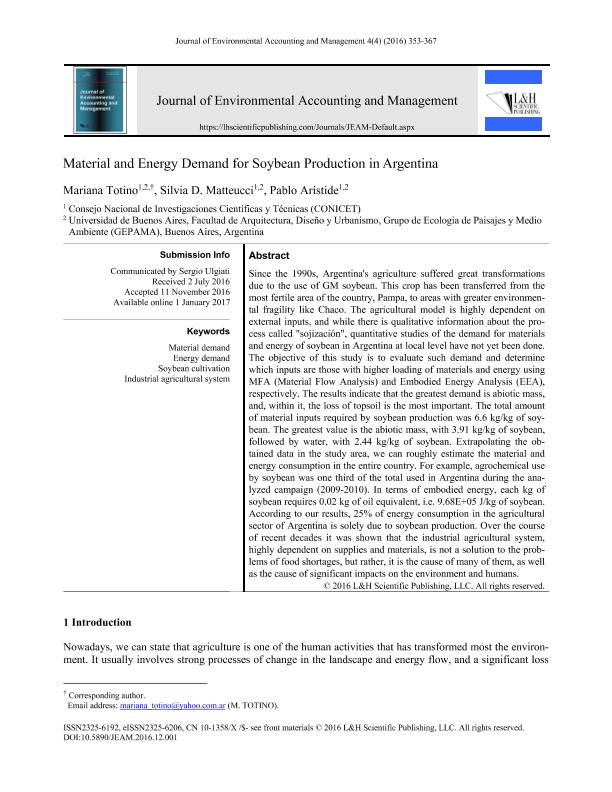Mostrar el registro sencillo del ítem
dc.contributor.author
Totino, Mariana

dc.contributor.author
Matteucci, Silvia Diana

dc.contributor.author
Arístide, Pablo

dc.date.available
2018-09-17T18:50:59Z
dc.date.issued
2016-11
dc.identifier.citation
Totino, Mariana; Matteucci, Silvia Diana; Arístide, Pablo; Material and energy demand for soybean production in Argentina; L & H Scientific Publishing; Journal of Environmental Accounting and Management; 4; 4; 11-2016; 353-367
dc.identifier.issn
2325-6192
dc.identifier.uri
http://hdl.handle.net/11336/59937
dc.description.abstract
Since the 1990s, Argentina's agriculture suffered great transformations due to the use of GM soybean. This crop has been transferred from the most fertile area of the country, Pampa, to areas with greater environmental fragility like Chaco. The agricultural model is highly dependent on external inputs, and while there is qualitative information about the process called "sojización", quantitative studies of the demand for materials and energy of soybean in Argentina at local level have not yet been done. The objective of this study is to evaluate such demand and determine which inputs are those with higher loading of materials and energy using MFA (Material Flow Analysis) and Embodied Energy Analysis (EEA), respectively. The results indicate that the greatest demand is abiotic mass, and, within it, the loss of topsoil is the most important. The total amount of material inputs required by soybean production was 6.6 kg/kg of soybean. The greatest value is the abiotic mass, with 3.91 kg/kg of soybean, followed by water, with 2.44 kg/kg of soybean. Extrapolating the obtained data in the study area, we can roughly estimate the material and energy consumption in the entire country. For example, agrochemical use by soybean was one third of the total used in Argentina during the analyzed campaign (2009-2010). In terms of embodied energy, each kg of soybean requires 0.02 kg of oil equivalent, i.e. 9.68E+05 J/kg of soybean. According to our results, 25% of energy consumption in the agricultural sector of Argentina is solely due to soybean production. Over the course of recent decades it was shown that the industrial agricultural system, highly dependent on supplies and materials, is not a solution to the problems of food shortages, but rather, it is the cause of many of them, as well as the cause of significant impacts on the environment and humans.
dc.format
application/pdf
dc.language.iso
eng
dc.publisher
L & H Scientific Publishing
dc.rights
info:eu-repo/semantics/openAccess
dc.rights.uri
https://creativecommons.org/licenses/by-nc-sa/2.5/ar/
dc.subject
Energy Demand
dc.subject
Industrial Agricultural System
dc.subject
Material Demand
dc.subject
Soybean Cultivation
dc.subject.classification
Ciencias Medioambientales

dc.subject.classification
Ciencias de la Tierra y relacionadas con el Medio Ambiente

dc.subject.classification
CIENCIAS NATURALES Y EXACTAS

dc.title
Material and energy demand for soybean production in Argentina
dc.type
info:eu-repo/semantics/article
dc.type
info:ar-repo/semantics/artículo
dc.type
info:eu-repo/semantics/publishedVersion
dc.date.updated
2018-09-14T13:17:46Z
dc.journal.volume
4
dc.journal.number
4
dc.journal.pagination
353-367
dc.journal.pais
China

dc.description.fil
Fil: Totino, Mariana. Universidad de Buenos Aires. Facultad de Arquitectura y Urbanismo. Grupo de Ecología del Paisaje y Medio Ambiente; Argentina. Consejo Nacional de Investigaciones Científicas y Técnicas; Argentina
dc.description.fil
Fil: Matteucci, Silvia Diana. Universidad de Buenos Aires. Facultad de Arquitectura y Urbanismo. Grupo de Ecología del Paisaje y Medio Ambiente; Argentina. Consejo Nacional de Investigaciones Científicas y Técnicas; Argentina
dc.description.fil
Fil: Arístide, Pablo. Universidad de Buenos Aires. Facultad de Arquitectura y Urbanismo. Grupo de Ecología del Paisaje y Medio Ambiente; Argentina. Consejo Nacional de Investigaciones Científicas y Técnicas; Argentina
dc.journal.title
Journal of Environmental Accounting and Management
dc.relation.alternativeid
info:eu-repo/semantics/altIdentifier/doi/http://dx.doi.org/10.5890/JEAM.2016.12.001
dc.relation.alternativeid
info:eu-repo/semantics/altIdentifier/url/https://www.lhscientificpublishing.com/Journals/JEAM-Download.aspx?volume=2016&issue=4
Archivos asociados
